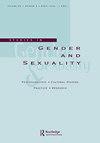介绍
Q3 Social Sciences
引用次数: 0
摘要
摘要本文介绍了拉普兰切性理论的主要内容。该模型侧重于他所说的“激进的交替”,指出性行为既是交易性的,来自另一方,构成了性欲的无意识和生活体验。在这一理论中,存在着创伤和规范性体验的空间,这些体验是从他者产生和到达的欲望和兴奋的形式;提出了与关系理论的联系,并介绍了从拉普兰契人的角度考虑临床、理论和文化的新颖性和重要性。本文章由计算机程序翻译,如有差异,请以英文原文为准。
Introduction
ABSTRACT This introduction presents the key elements in Laplanche’s theorizing about sexuality. The model focuses on what he has termed “radical alterity,” noting that sexuality is both transactional, arriving from the other and constituting both the unconscious and the lived experience of sexual desire. In this theory, there is space for trauma and normative experiences of forms of desire and excitement arising and arriving from the Other; links to relational theory are suggested and the novelty and importance of considering the clinical, the theoretical, and the cultural from a Laplanchian perspective are introduced.
求助全文
通过发布文献求助,成功后即可免费获取论文全文。
去求助
来源期刊

Studies in Gender and Sexuality
Social Sciences-Gender Studies
CiteScore
0.80
自引率
0.00%
发文量
15
期刊介绍:
Beginning in the final two decades of the 20th century, the study of gender and sexuality has been revived from a variety of directions: the traditions of feminist scholarship, postclassical and postmodern psychoanalytic theory, developmental research, and cultural studies have all contributed to renewed fascination with those powerfully formative aspects of subjectivity that fall within the rubric of "gender" and "sexuality." Clinicians, for their part, have returned to gender and sexuality with heightened sensitivity to the role of these constructs in the treatment situation, including the richly variegated ways in which assumptions about gender and sexuality enter into our understandings of "normality" and "pathology."
 求助内容:
求助内容: 应助结果提醒方式:
应助结果提醒方式:


